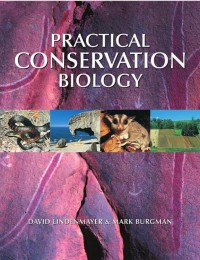2012: A Year of Custodial Responsibility!
Saturday, December 31st, 2011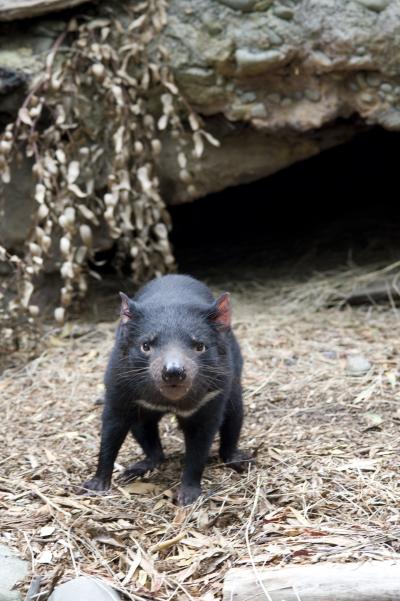 Tasmanian Devil (Sarcophilus harrisii) – a healthy one
.
Tasmanian Devil (Sarcophilus harrisii) – a healthy one
.
Extinction of the species is a possibility within the next two decades unless a recently discovered infectious cancer,
Devil Facial Tumour Diseased (DFTD) spread can be stopped.
. [Source: University of Adelaide zoologist Dr Austin who since 2008 has been leading a national project to help save the endangered Tasmanian devil from extinction. ^http://www.sciencedaily.com/releases/2008/11/081103164725.htm]..
Spate of wildlife diseases across human-contaminated Tasmania
.Dr David Obendorf, Wildlife Veterinary Pathologist in Tasmania, says that the recent outbreak of disease killing off Tasmanian Devils is symptomatic of similar recent diseases affecting other wildlife the same areas of Tasmania, which is impacting on their survival.
Coming out of nowhere for Tasmania is ‘Mucor amphibiorum‘, a fungal disease in platypus and frogs which doesn’t occur on the mainland and yet we know that, that organism occurs on the mainland. Tasmania now has a cat borne infection ‘Toxoplasmosis‘ which is spread by feral cats which kills wallabies, wombats, bandicoots. Tasmania has a new staphylococcal infection that infests the pads of echidnas so they get this sort of raw pustular wound that impregnates their pads they, they just can’t dig. Tasmanian wombats have developed Sarcoptic mange, you know, a little mite that burrows into skin causing intensely painful skin lesion where they develop all this weeping skin and they become like armour plated animals just losing their skin. They walk around like sort of robots because they just can’t stretch out, there’s no flexibility left in their skin. These animals die an incredibly painful death as a result of having this disease.
The Tasmanian Government after great reluctance, says Dr David Obendorf, has published a report listing about twenty two significant wildlife diseases (just in the past 30 years) that are impacting Tasmanian wildlife. In frogs, in wombats, in bandicoots, in wallabies, in devils, in seals, in birds. We’re trying to maintain threatened species in the face of viral infections, parasitic infections, fungal infections. You’ve got to ask yourself the question, why, why all of a sudden do we have all this pathogen stress on wildlife?
Dr David Obendorf contributes the spate of Tasmania’s wildlife diseases to human abuse of the environment – pesticide and herbicide spraying, biocide contamination of streams, the continuation of habitat fragmentation and habitat destruction, allowing these diseases to be transmitted more easily and compounding pathogen stresses on wildlife.
You’d be a fool not to try and see if there’s one health underpinning for a scenario such as what appeared to have been occurring in the north east region of Tasmania. That region had undergone massive land transformation and the introduction of silvi-cultural plantations over vast catchments and the beginnings of usages of chemicals that were being aerial sprayed over large acreages.
The north east corner of Tasmania has undergone massive transformation since the Regional Forest Agreement was signed in 1996. You have a mosaic of landscapes now created with silvi cultural plantations, hardwood plantations of nitens, (Ed: genetically manipulated) Eucalyptus nitens trees. You have some fragmented pockets of natural environment. You have dairy farms. You have small villages and you have the large settlement of St Helen’s which is at the end of the catchment of the George River. So in that sort of context chemical usage has really come into being a dominant player in the sort of risk management of that whole environment. Because you’re dealing with herbicides and pesticides, insecticides, the use of 1080 for a long time as well. So all these things are playing into that landscape and affecting how the water may pick up those residues and the impact it might have on oysters. But also on the bio-accumulation risk that it would represent to the species, the native species that are living in natural ecosystems.
The big issue is when are these sorts of relationships between ecology, wildlife, humans…is there a relationship here between an event, a sudden event, mass mortality, and something that may well have affected that ecology or that environment to contaminate it?’
[Source: Dr David Obendorf, Wildlife Veterinary Pathologist, ABC Television interview transcript, Australian Story, 20100222, ^http://www.abc.net.au/austory/content/2007/s2827187.htm].
.
Australian Mammal Extinction Crisis
.
The demise of the Tasmanian Devil is symptomatic of the harm 21st Century human activities are causing to Australia’s wildlife habitat and wildlife in general.
‘Australia has one of the worst mammal extinction rates in the world, with 22 mammals becoming extinct over the past 200 years, including the Bridled Nailtail Wallaby (Onychogalea fraenata), now listed as endangered. Broadscale bushfire (wildfire or hazard reduction), altered fire regimes including frequent fire, compounded with feral cat predation and introduced herbivores have caused major population decline in many small native mammals such as the Greater Bilby (Macrotis lagotis), the Brush-tailed Tree Rat (Conilurus penicillatus) native to northern Australia.
‘While rigorous efforts have been made to save endangered groups, scientists now fear Australia is on the cusp of another wave of extinctions with a reduction in abundance of some species and alarmingly their range. Some mammal species have already disappeared from more than 90% of their past range in Northern Australia. Such is the seriousness of the situation, that Professor Iain Gordon from CSIRO Sustainable Ecosystems is chairing a meeting at the International Ecology Symposium in Brisbane on Australia’s mammal extinction crisis.’
[Source: CSIRO, 20090807, ^http://www.csiro.au/Portals/Multimedia/CSIROpod/Australian-Mammal-Extinction-Crisis.aspx, visit this website to listen to a podcast by Professor Gordon discusses some of the science research being developed to save endangered species].
‘Some species have already disappeared from more than 90% of their past range across the North. Many formerly abundant animals such as the Northern Quoll (Dasyurus hallucatus), Golden Bandicoot (Isoodon auratus) , and Greater Bilby (Macrotis lagotis) are declining, and doing so very rapidly. The declines are being reported from pastoral lands, indigenous lands, and national parks alike.’
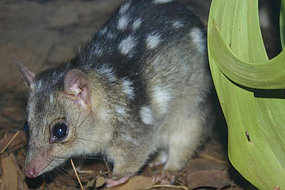 Baby Northern Quoll
Baby Northern Quoll
.
‘Northern Australia is the largest remaining tropical savanna on Earth. However, changes in land management have meant that many mammals in these savannas are now struggling to find enough food and shelter to survive. A range of factors, such as feral cats, unmanaged (Ed: read ‘neglected’) fire and over‐grazing are implicated in causing these declines.’
‘The meeting unanimously agreed that decisive and immediate action across all land tenures is needed if we are to save species. This includes developing and implementing land management work plans as well as research plans to fill in priority knowledge gaps.’
‘In part we need to better understand the detail of what each native mammal needs to survive. However, we do know enough now to immediately assist and support landholders across Northern Australia to do the on‐ground management work needed ‐ work such as feral animal control and managing fire ‐ which we know will immediately assist these threatened species.’
‘This is undoubtedly one of the major biodiversity conservation issues affecting Australia, which already has the worst rate of mammal extinctions in the world.
‘It would be heartbreaking and internationally embarrassing if we were to stand aside and witness another wave of extinctions without making any effort to intervene. The only way to reduce the chance of extinctions in our iconic northern Australian mammals over the next decade is to take urgent action now’.
~ Dr. Sarah Legge of Australian Wildlife Conservancy (Ed: that was in May 2010. It is now January 2012, 18 months later!)
[Source: ‘Extinction crisis for North Australia’s mammals’, Australian Wildlife Conservancy and The Wilderness Society WA Inc., ^http://www.wilderness.org.au/articles/extinction-crisis-for-north-australias-mammals].
‘Of the 85 species of native mammals (excluding bats) known to have once occupied Australia’s northern arid zone (including the Pilbara region of Western Australia), 11 are now extinct, six are extinct on the mainland and are found only on off-shore islands and 16 are now severely restricted in their range.’
[Source: ‘Extinction crisis for North Australia’s mammals’ , Wildlife Preservation Society of Australia – Bilby Projects, 20100514, ^http://wpsa.org.au/pro_bilby.html].
Northern Territory Mammals
.
‘Extinct’
.
- Burrowing Bettong (inland species) (Bettongia lesueur graii)
- Brush-tailed Bettong (Bettongia penicillata)
- Pig-footed bandicoot (Chaeropus ecaudatus)
- Western Quoll (Dasyurus geoffroii)
- Central Hare-wallaby (Lagorchestes asomatus)
- Lesser Stick-nest Rat (Leporillus apicalis)
- Lesser Bilby (Macrotis leucura)
- Numbat (Myrmecobius fasciatus)
- Short-tailed Hopping-mouse (Notomys amplus)
- Long-tailed Hopping-mouse (Notomys longicaudatus)
- Crescent Nailtail Wallaby (Onychogalea lunata)
- Desert Bandicoot (Perameles eremiana)
- Red-tailed Phascogale (Phascogale calura)
- Alice Springs Mouse (Pseudomys fieldi)
.
‘Extinct in the Wild’ ?
.
- Mala (Lagorchestes hirsutus)
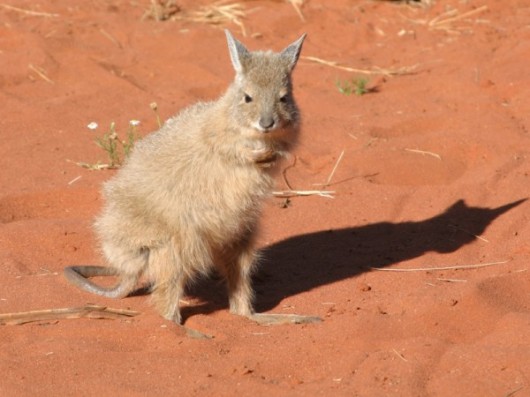 Mala
Only 200 in the world, centred around Uluru-Kata Tjuta National Park (September 2011)
Mala
Only 200 in the world, centred around Uluru-Kata Tjuta National Park (September 2011)
.
‘Critically Endangered’ (only a handful left)
.
- Northern Quoll (Dasyurus hallucatus)
- Golden-backed Tree-rat (Mesembriomys macrurus)
- Carpentarian Rockrat (Zyzomys palatalis)
.
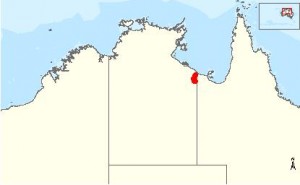 Severely restricted distribution of the Carpentarian Rock-rat
Severely restricted distribution of the Carpentarian Rock-rat
.
‘Endangered’
.
- Golden Bandicoot (Isoodon auratus)
- Fawn Hopping-mouse (Notomys cervinus)
- Dusky Hopping-mouse (Notomys fuscus)
- Carpentarian Antechinus (Pseudantechinus mimulus)
- Plains Rat (Pseudomys australis)
- Common Brushtail Possum (Central Australian subspecies) (Trichosurus vulpecula vulpecula)
- Central Rock-rat (Zyzomys pedunculatus)
.
Plus other mammal species classified as ‘Vulnerable‘, as well as many native birds, reptiles, amphibians, fish, invertebrates, and plants that are also extinct or approaching extinction.
.
Source:: ^http://www.nretas.nt.gov.au/plants-and-animals/animals/home/specieslist
.
.
Custodial Responsibility
.
“It’s really this sense of apathy and the belief that somehow wildlife is a nuisance and if they die, well, you know, well, what do you expect us to do about it?…wildlife (is) really just a small hobby sideline area of investigation.”
~ Dr David Obendorf
.
Governments have an entrusted responsibility, delegated to them and financed by the communities they represent, to be competent and active custodial managers of a State’s natural values. Government agencies charged with custodial responsibility for natural ecosystems and native flora and fauna have a moral obligation to be honest and conscientious in properly maintain the integrity (the wholeness and intactness) of a State’s natural heritage.
International Environmental Law has adopted a number of important guiding principles which need to form the policy bases and plans of management for managing our natural heritage – including the polluter pays principle, the precautionary principle, the principle of sustainable development, and intra-generational and inter-generational equity.
‘Any judgment made today that has an adverse impact on natural populations, particularly if it involves the extinction of a species or communities, is likely to be irrevocable (Beattie and Ehrlich, 2001).
Custodial responsibility, sometimes called the principle of inter-generational equity, underpins both the intrinsic value and the utilitarian cases for conservation. The Intergovernmental Agreement on the Environment (Australian Government Publishing Service, 1992, para 3.5.1) defined the precautionary principal as:
‘Where there are threats of serious or irreversible environmental damage, lack of full scientific certainty should not be used as a reason for postponing measures to prevent environmental degradation.’
Back in 1863, the great biogeographer and evolutionary biologist, Alfred Wallace, made a clear statement about custodial responsibility:
“…future ages will certainly look back on us as people so immersed in the pursuit of wealth as to be blind to higher considerations. They will charge us with having culpability allowed the destruction of some…[species]…which we had it in our power to preserve; and while professing to regard every living thing,…with a strange inconsistency, seeing many of them perish irrecoverably from the face of the Earth, uncared for and unknown (p.234).”
.
[Source: ‘Practical conservation biology‘, text by David Lindenmayer, Mark A. Burgman, 2005, CSIRO Publishing, Australia, ISBN 0 643 09089 4].
‘Human beings are part of the natural world, and all forms of life on Earth deserve our respect.’ (Australian Greens Principle #1).
May we learn from our forefathers’ wanton and misguided persecution of the now ‘fabled’ Tasmanian Tiger. May we learn from our current fathers’ misguided exploitation of wildlife habitat as a ‘natural resource‘. May we in 2012 take all efforts and funding to prevent the Tasmanian Devil becoming another fabled tragedy of our making. May 2012 be a break-though year for those, especially young people, trying to convince governments the virtue of mature respect for our fragile natural world.
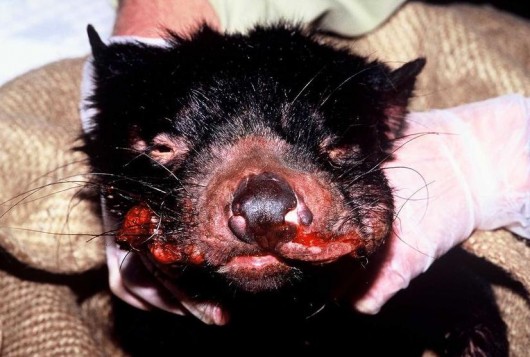 Tasmanian Devil (Sarcophilus harrisii) – a species now dying out
Tasmanian Devil (Sarcophilus harrisii) – a species now dying out
